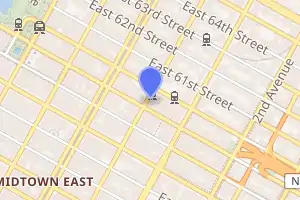Lexington Avenue/59th Street station
Lexington Avenue/59th Street (signed as 59th Street–Lexington Avenue) is a New York City Subway station complex shared by the IRT Lexington Avenue Line and the BMT Broadway Line. It is located at Lexington Avenue between 59th and 60th Streets, on the border of Midtown and the Upper East Side of Manhattan. The station complex is the fourteenth-busiest in the system, with over 21 million passengers in 2016.[5]
Lexington Avenue/59 Street | |||||||||||||
|---|---|---|---|---|---|---|---|---|---|---|---|---|---|
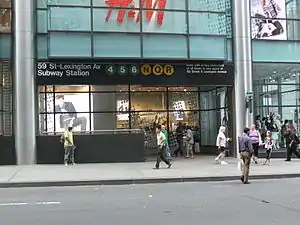 Street stair by southeast corner of 59th Street and Lexington Avenue (The Q train served this station during the W's discontinuation from 2010-2016) | |||||||||||||
| Station statistics | |||||||||||||
| Address | East 59th Street & Lexington Avenue New York, NY 10022[1] | ||||||||||||
| Borough | Manhattan | ||||||||||||
| Locale | Midtown Manhattan, Upper East Side | ||||||||||||
| Coordinates | 40.762471°N 73.9679°W | ||||||||||||
| Division | A (IRT), B (BMT) | ||||||||||||
| Line | BMT Broadway Line IRT Lexington Avenue Line | ||||||||||||
| Services | 4 5 6 N R W | ||||||||||||
| System transfers | With MetroCard or OMNY only: F N Q R | ||||||||||||
| Transit | |||||||||||||
| Structure | Underground | ||||||||||||
| Levels | 3 | ||||||||||||
| Other information | |||||||||||||
| Opened | July 1, 1948[3] | ||||||||||||
| Station code | 613[4] | ||||||||||||
| Accessible | not ADA-accessible; accessibility planned | ||||||||||||
| Traffic | |||||||||||||
| 2019 | 16,760,813[5] | ||||||||||||
| Rank | 15 out of 424[5] | ||||||||||||
| |||||||||||||
| |||||||||||||
| |||||||||||||
It is served by the 4, 6, and N trains at all times, the W train on weekdays, and the 5 and R trains at all times except late nights. In addition, the <6> express train stops here during weekdays in peak direction.
A free out-of-system MetroCard/OMNY transfer is available to the 63rd Street Lines (F and Q trains, as well as rush-hour N and R, and evening and weekend M trains) by exiting the station and walking to the Lexington Avenue–63rd Street station.
History
Lexington Avenue Line station
Following the completion of the original subway, there were plans to construct a line along Manhattan's east side north of 42nd Street. The original plan for what became the extension north of 42nd Street was to continue it south through Irving Place and into what is now the BMT Broadway Line at Ninth Street and Broadway. In July 1911, the IRT had withdrawn from the talks, and the Brooklyn Rapid Transit Company (BRT) was to operate on Lexington Avenue. The IRT submitted an offer for what became its portion of the Dual Contracts on February 27, 1912.[6][7]
In 1913, as part of the Dual Contracts, which were signed on March 19, 1913,[8] the Public Service Commission planned to split the original Interborough Rapid Transit Company (IRT) system from looking like a "Z" system (as seen on a map) to an "H"-shaped system. The original system would be split into three segments: two north–south lines, carrying through trains over the Lexington Avenue and Broadway–Seventh Avenue Lines, and a west–east shuttle under 42nd Street. This would form a roughly "H"-shaped system.[9][10] It was predicted that the subway extension would lead to the growth of the Upper East Side and the Bronx.[11][12]
The Lexington Avenue Line station at 59th Street opened on July 17, 1918, with service initially running between Grand Central–42nd Street station and 167th Street via the line's local tracks.[13] On August 1, the "H system" was put into place, with through service beginning on the new east and west side trunk lines, and the institution of the 42nd Street Shuttle along the old connection between the sides.[14] The cost of the extension from Grand Central was $58 million.[15]
Broadway Line station
The New York Public Service Commission adopted plans for what was known as the Broadway–Lexington Avenue route on December 31, 1907. This route began at the Battery and ran under Greenwich Street, Vesey Street, Broadway to Ninth Street, private property to Irving Place, and Irving Place and Lexington Avenue to the Harlem River. After crossing under the Harlem River into the Bronx, the route split at Park Avenue and 138th Street, with one branch continuing north to and along Jerome Avenue to Woodlawn Cemetery, and the other heading east and northeast along 138th Street, Southern Boulevard, and Westchester Avenue to Pelham Bay Park. In early 1908, the Tri-borough plan was formed, combining this route, the under-construction Centre Street Loop Subway in Manhattan and Fourth Avenue Subway in Brooklyn, a Canal Street subway from the Fourth Avenue Subway via the Manhattan Bridge to the Hudson River, and several other lines in Brooklyn.[16][17]
The Brooklyn Rapid Transit Company submitted a proposal to the Commission, dated March 2, 1911, to operate the Tri-borough system (but under Church Street instead of Greenwich Street), as well as a branch along Broadway, Seventh Avenue, and 59th Street from Ninth Street north and east to the Queensboro Bridge; the Canal Street subway was to merge with the Broadway Line instead of continuing to the Hudson River. The city, the BRT, and the Interborough Rapid Transit Company (which operated the first subway and four elevated lines in Manhattan) came to an agreement, and sent a report to the New York City Board of Estimate on June 5, 1911. The line along Broadway to 59th Street was assigned to the BRT, while the IRT obtained the Lexington Avenue line, connecting with its existing route at Grand Central–42nd Street. Construction began on Lexington Avenue on July 31, and on Broadway the next year. The Dual Contracts, two operating contracts between the city and the BMT and IRT, were adopted on March 4, 1913.[18]
Unused construction is also present near the west end of the Queensboro Bridge. The original plan there was to build two one-track tunnels under 59th and 60th Streets, rising onto the bridge to Queens. However, on July 28, 1915, the Public Service Commission approved a change of plans requested by the New York City Board of Estimate to place both tracks under 60th Street and cross the East River in the 60th Street Tunnel,[19] because of concern whether or not the bridge could handle the weight of all-steel subway trains. A piece of the 59th Street tunnel had already been built, concurrent with the construction of the IRT Lexington Avenue Line, and became a walkway connecting the two side platforms of the IRT's 59th Street station.[20][21][22]
This station opened on September 1, 1919 as the new terminal of the Broadway Line with an extension of the line from 57th Street–Seventh Avenue station.[23][24] This station ceased to be the line's terminal with the extension of the line to Queensboro Plaza through the 60th Street Tunnel on August 1, 1920.[25][26]
Station renovations
The station originally served local trains only.[27] On November 4, 1954, the New York City Transit Authority (NYCTA) approved plans to convert 59th Street into an express station. The project was proposed by the executive director of the NYCTA, Sidney Bingham, to improve connections between the Lexington Avenue Line and the Broadway Line. Construction was expected to take two years and cost $5 million. The new express stop was expected to reduce transfer congestion at Grand Central–42nd Street.[28] Even before the express platforms were added, this station was the busiest on the line.[29][30]
Construction for the express station began on August 10, 1959. Along with the new express platforms, a new mezzanine was built above it to connect it to the local station, and the Broadway Line station. Two high speed escalators were added to connect the local and express platforms. Two additional high speed escalators were built to connect the local platforms with the new mezzanine. The express station opened three months earlier than originally planned. As part of the plan, the local platforms were extended to accommodate 10-car trains. In addition, new entrances and booths were added to the 59th Street ends of the northbound and southbound sides. The whole cost of the project was $6.5 million.[23] Work on the express station at 59th Street, required express trains to run local during late nights.[31] The express platforms were opened on November 15, 1962.[23]
The Third Avenue entrance to the Broadway Line platform was constructed during the early 1970s as part of a project to extend the station's platform to accommodate ten-car trains. The entrance, which opened in October 1973, has the same red tile that was used during renovation of Bowling Green in 1978. It has up and down escalators and an adjoining staircase, and is open part-time only, with four street staircases on Third Avenue.
In 2002, the Broadway Line station received a major overhaul. It received a state of repairs with the original late 1910s tiling being restored. The Metropolitan Transportation Authority (MTA) repaired the staircases, re-tiled the walls, added new tiling on the floors, upgraded the station's lights and the public address system, and installed ADA yellow safety threads along the platform edge, new signs, and new trackbeds in both directions. Despite this, the project did not make the station ADA-accessible.[32]
In 2019, the MTA announced that the station would become ADA-accessible as part of the agency's 2020–2024 Capital Program.[32]
Station layout
| G | Street level | Exits/entrances, MetroCard/OMNY connection to |
| B1 | Third Avenue mezzanine | Fare control, MetroCard machines, to Broadway Line platforms |
| Fare control, MetroCard machines, to northbound platforms and Bloomingdale's | ||
| Side platform | ||
| Northbound local | ← ← | |
| Southbound local | | |
| Side platform | ||
| Fare control, MetroCard machines, to southbound platforms | ||
| B2 | Crossunder | Crossunder between local platforms |
| Southbound | ← ← ← | |
| Island platform | ||
| Northbound | | |
| B3 | Mezzanine | Transfer between platforms |
| B4 | Side platform | |
| Northbound express | ← ← | |
| Southbound express | | |
| Side platform | ||
The center level is located at the 60th Street/Lexington Avenue end. Installed in conjunction with the 1962 opening of the lower level IRT express platforms, it allows transfer between all routes. There are three staircases up to the BMT platform, two down to each of the lower level IRT express platforms, and one staircase and escalator up to the IRT local platforms on the upper level.
Artwork
The mezzanine between the IRT express platforms and the BMT platform has a large-scale mosaic mural entitled Blooming (1996), by Elizabeth Murray. It covers all four walls of the mezzanine area. It takes its name from the nearby Bloomingdale's department store.[33] The mosaic features larger versions of the coffee cups and slippers found on the platform walls, with the text: "In dreams begin responsibilities" and "Conduct your blooming in the noise and whip of the whirlwind". The text floats from the coffee cups and are excerpted from poetry by Delmore Schwartz and Gwendolyn Brooks. Additional, mini shoe mosaics can be found on the IRT express platforms.
This is one of two murals Murray made for MTA Arts & Design; the other, Stream, can be found at Court Square/23rd Street.
Entrances and exits
The complex has a total of 11 staircase entrances. There are staircases to the Broadway Line platform and that are signed for the northbound Lexington Avenue Line platform at the eastern corners of 60th Street and Lexington Avenue, and staircases to the Broadway Line platform and that are signed for the southbound Lexington Avenue Line platform at the western corners of 60th Street and Lexington Avenue. Staircases from the southbound Lexington Avenue Line platform lead to the southwestern and northwestern corners of Lexington Avenue and 59th Street, while there are two exits to the southeastern corner of that intersection from the northbound platform, with one leading directly to the street, and one located in a passageway to Bloomingdale's. The station also has staircases to all four corners of Third Avenue and 60th Street, leading to a mezzanine with escalators for the Broadway Line platform.[34]
IRT Lexington Avenue Line platforms
59 Street | |||||||||||||||||||||||||||||||||||||||||||||||||||||||||||||||||||||||||||||||||||||||||||||||||||||||||||||||||||||||||||||||||||||||||||||||||||||||||||||||||||||||||||||||||||||||||||||||||||||
|---|---|---|---|---|---|---|---|---|---|---|---|---|---|---|---|---|---|---|---|---|---|---|---|---|---|---|---|---|---|---|---|---|---|---|---|---|---|---|---|---|---|---|---|---|---|---|---|---|---|---|---|---|---|---|---|---|---|---|---|---|---|---|---|---|---|---|---|---|---|---|---|---|---|---|---|---|---|---|---|---|---|---|---|---|---|---|---|---|---|---|---|---|---|---|---|---|---|---|---|---|---|---|---|---|---|---|---|---|---|---|---|---|---|---|---|---|---|---|---|---|---|---|---|---|---|---|---|---|---|---|---|---|---|---|---|---|---|---|---|---|---|---|---|---|---|---|---|---|---|---|---|---|---|---|---|---|---|---|---|---|---|---|---|---|---|---|---|---|---|---|---|---|---|---|---|---|---|---|---|---|---|---|---|---|---|---|---|---|---|---|---|---|---|---|---|---|---|
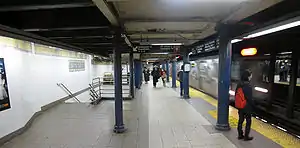 An uptown 6 train of R142A cars enters on the local platform | |||||||||||||||||||||||||||||||||||||||||||||||||||||||||||||||||||||||||||||||||||||||||||||||||||||||||||||||||||||||||||||||||||||||||||||||||||||||||||||||||||||||||||||||||||||||||||||||||||||
| Station statistics | |||||||||||||||||||||||||||||||||||||||||||||||||||||||||||||||||||||||||||||||||||||||||||||||||||||||||||||||||||||||||||||||||||||||||||||||||||||||||||||||||||||||||||||||||||||||||||||||||||||
| Division | A (IRT) | ||||||||||||||||||||||||||||||||||||||||||||||||||||||||||||||||||||||||||||||||||||||||||||||||||||||||||||||||||||||||||||||||||||||||||||||||||||||||||||||||||||||||||||||||||||||||||||||||||||
| Line | IRT Lexington Avenue Line | ||||||||||||||||||||||||||||||||||||||||||||||||||||||||||||||||||||||||||||||||||||||||||||||||||||||||||||||||||||||||||||||||||||||||||||||||||||||||||||||||||||||||||||||||||||||||||||||||||||
| Services | 4 5 6 | ||||||||||||||||||||||||||||||||||||||||||||||||||||||||||||||||||||||||||||||||||||||||||||||||||||||||||||||||||||||||||||||||||||||||||||||||||||||||||||||||||||||||||||||||||||||||||||||||||||
| Levels | 2 | ||||||||||||||||||||||||||||||||||||||||||||||||||||||||||||||||||||||||||||||||||||||||||||||||||||||||||||||||||||||||||||||||||||||||||||||||||||||||||||||||||||||||||||||||||||||||||||||||||||
| Platforms | 4 side platforms (2 on each level) | ||||||||||||||||||||||||||||||||||||||||||||||||||||||||||||||||||||||||||||||||||||||||||||||||||||||||||||||||||||||||||||||||||||||||||||||||||||||||||||||||||||||||||||||||||||||||||||||||||||
| Tracks | 4 (2 on each level) | ||||||||||||||||||||||||||||||||||||||||||||||||||||||||||||||||||||||||||||||||||||||||||||||||||||||||||||||||||||||||||||||||||||||||||||||||||||||||||||||||||||||||||||||||||||||||||||||||||||
| Other information | |||||||||||||||||||||||||||||||||||||||||||||||||||||||||||||||||||||||||||||||||||||||||||||||||||||||||||||||||||||||||||||||||||||||||||||||||||||||||||||||||||||||||||||||||||||||||||||||||||||
| Opened | July 17, 1918[13] (upper level) November 15, 1962 (lower level)[23] | ||||||||||||||||||||||||||||||||||||||||||||||||||||||||||||||||||||||||||||||||||||||||||||||||||||||||||||||||||||||||||||||||||||||||||||||||||||||||||||||||||||||||||||||||||||||||||||||||||||
| Station code | 400[4] | ||||||||||||||||||||||||||||||||||||||||||||||||||||||||||||||||||||||||||||||||||||||||||||||||||||||||||||||||||||||||||||||||||||||||||||||||||||||||||||||||||||||||||||||||||||||||||||||||||||
| Accessible | |||||||||||||||||||||||||||||||||||||||||||||||||||||||||||||||||||||||||||||||||||||||||||||||||||||||||||||||||||||||||||||||||||||||||||||||||||||||||||||||||||||||||||||||||||||||||||||||||||||
| Opposite- direction transfer | Yes | ||||||||||||||||||||||||||||||||||||||||||||||||||||||||||||||||||||||||||||||||||||||||||||||||||||||||||||||||||||||||||||||||||||||||||||||||||||||||||||||||||||||||||||||||||||||||||||||||||||
| Station succession | |||||||||||||||||||||||||||||||||||||||||||||||||||||||||||||||||||||||||||||||||||||||||||||||||||||||||||||||||||||||||||||||||||||||||||||||||||||||||||||||||||||||||||||||||||||||||||||||||||||
| Next north | 86th Street (express): 4 68th Street–Hunter College (local): 4 | ||||||||||||||||||||||||||||||||||||||||||||||||||||||||||||||||||||||||||||||||||||||||||||||||||||||||||||||||||||||||||||||||||||||||||||||||||||||||||||||||||||||||||||||||||||||||||||||||||||
| Next south | 51st Street (local): 4 Grand Central–42nd Street (express): 4 | ||||||||||||||||||||||||||||||||||||||||||||||||||||||||||||||||||||||||||||||||||||||||||||||||||||||||||||||||||||||||||||||||||||||||||||||||||||||||||||||||||||||||||||||||||||||||||||||||||||
| |||||||||||||||||||||||||||||||||||||||||||||||||||||||||||||||||||||||||||||||||||||||||||||||||||||||||||||||||||||||||||||||||||||||||||||||||||||||||||||||||||||||||||||||||||||||||||||||||||||
| |||||||||||||||||||||||||||||||||||||||||||||||||||||||||||||||||||||||||||||||||||||||||||||||||||||||||||||||||||||||||||||||||||||||||||||||||||||||||||||||||||||||||||||||||||||||||||||||||||||
59th Street on the IRT Lexington Avenue Line is an express station. It has two stacked levels, each of which has two tracks and two side platforms. The upper level is used by local trains, and the lower level is used by express trains. The levels are separated by the BMT Broadway Line's platform directly underneath the local platforms and a mezzanine between the BMT platform and the express level. Long escalators connect the local and express platforms directly.


The station used to have all green tile which has been covered up except for one "59th Street" sign near the south end of the northbound platform. There are whimsical stylized mosaics of coffee cups and slippers in varied colors at random spacing near the stairways to the Broadway and IRT local trains. This station was renovated in conjunction with the construction of the Bloomberg Tower at 59th Street and Lexington Avenue. Although a new entrance was constructed within the building, it has remained closed due to fears of icicle formation on a railing that is part of the building's design, directly above the street entrance. A legal battle between the city and the building's management over who is responsible for modifying the design caused the entrance to be temporarily closed between 2003 and 2006.
There is a direct exit to Bloomingdale's from the uptown local platform's fare control (this exit was used in the 2008 film Cloverfield). The underpass near the south end of the station was originally the northbound platform for the extension of the BMT Broadway Line to Queens. That line had been planned as two separate, one-track tunnels, one each under 59th and 60th Streets. Later on, it was decided to alter this layout in favor of a single two-track tunnel under 60th Street. The semi-completed platform under 59th Street was then converted to an underpass between the north and southbound platforms of the Lexington Avenue Line local tracks.
On the upper level, north of the station, there is a storage/lay up track between the two tracks. It ends at a bumper block at its north end. It merges with the two local tracks on its southern end.
Image gallery
 The Lexington Avenue lower-level express station, opened in 1962
The Lexington Avenue lower-level express station, opened in 1962 A new, still unused entrance/exit. It has since opened
A new, still unused entrance/exit. It has since opened Elizabeth Murray's artwork
Elizabeth Murray's artwork
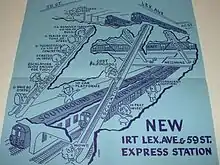 Brochure for the opening of the 59th Street express platforms
Brochure for the opening of the 59th Street express platforms
BMT Broadway Line platform
Lexington Avenue−59 Street | ||||||||||||||||||||||||||||||||||||||||||||||||||||||||||||||||||||||||||||||||||||||||||||||||
|---|---|---|---|---|---|---|---|---|---|---|---|---|---|---|---|---|---|---|---|---|---|---|---|---|---|---|---|---|---|---|---|---|---|---|---|---|---|---|---|---|---|---|---|---|---|---|---|---|---|---|---|---|---|---|---|---|---|---|---|---|---|---|---|---|---|---|---|---|---|---|---|---|---|---|---|---|---|---|---|---|---|---|---|---|---|---|---|---|---|---|---|---|---|---|---|---|
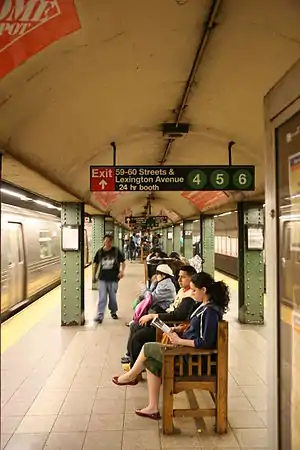 Platform view | ||||||||||||||||||||||||||||||||||||||||||||||||||||||||||||||||||||||||||||||||||||||||||||||||
| Station statistics | ||||||||||||||||||||||||||||||||||||||||||||||||||||||||||||||||||||||||||||||||||||||||||||||||
| Division | B (BMT) | |||||||||||||||||||||||||||||||||||||||||||||||||||||||||||||||||||||||||||||||||||||||||||||||
| Line | BMT Broadway Line | |||||||||||||||||||||||||||||||||||||||||||||||||||||||||||||||||||||||||||||||||||||||||||||||
| Services | N R W | |||||||||||||||||||||||||||||||||||||||||||||||||||||||||||||||||||||||||||||||||||||||||||||||
| Platforms | 1 island platform | |||||||||||||||||||||||||||||||||||||||||||||||||||||||||||||||||||||||||||||||||||||||||||||||
| Tracks | 2 | |||||||||||||||||||||||||||||||||||||||||||||||||||||||||||||||||||||||||||||||||||||||||||||||
| Other information | ||||||||||||||||||||||||||||||||||||||||||||||||||||||||||||||||||||||||||||||||||||||||||||||||
| Opened | September 1, 1919[35] | |||||||||||||||||||||||||||||||||||||||||||||||||||||||||||||||||||||||||||||||||||||||||||||||
| Station code | 008[4] | |||||||||||||||||||||||||||||||||||||||||||||||||||||||||||||||||||||||||||||||||||||||||||||||
| Accessible | not ADA-accessible; accessibility planned | |||||||||||||||||||||||||||||||||||||||||||||||||||||||||||||||||||||||||||||||||||||||||||||||
| Accessibility | Same-platform wheelchair transfer available | |||||||||||||||||||||||||||||||||||||||||||||||||||||||||||||||||||||||||||||||||||||||||||||||
| Opposite- direction transfer | Yes | |||||||||||||||||||||||||||||||||||||||||||||||||||||||||||||||||||||||||||||||||||||||||||||||
| Station succession | ||||||||||||||||||||||||||||||||||||||||||||||||||||||||||||||||||||||||||||||||||||||||||||||||
| Next east | Queensboro Plaza (Astoria): N Queens Plaza (Queens Boulevard): R | |||||||||||||||||||||||||||||||||||||||||||||||||||||||||||||||||||||||||||||||||||||||||||||||
| Next west | Fifth Avenue–59th Street: N | |||||||||||||||||||||||||||||||||||||||||||||||||||||||||||||||||||||||||||||||||||||||||||||||
| ||||||||||||||||||||||||||||||||||||||||||||||||||||||||||||||||||||||||||||||||||||||||||||||||
| ||||||||||||||||||||||||||||||||||||||||||||||||||||||||||||||||||||||||||||||||||||||||||||||||
Lexington Avenue−59th Street on the BMT Broadway Line has two tracks and one island platform, and two mezzanines. The Lexington Avenue mezzanine has two staircases to each of the IRT local platforms, an escalator to the downtown platform, and three staircases down to the center level.
The distinctive "Lex" mosaics were preserved during the renovation, by installing pre-arranged blocks along the station wall that cup the Lexington Avenue Line above it. The wall tiles have the red "Lex" evenly spaced out, similar to the IND style, with blue background, green borders, and white lettering.
Despite its name, the station is located on Lexington Avenue and 60th Street, one block north of 59th Street. Originally, the Broadway subway was to run to Queens over the Queensboro Bridge. Because the side streets are so narrow, the Queens-bound track was to run under 59th Street and the downtown-bound track under 60th Street.[36] The Broadway subway plan was changed in 1915 to route both tracks into 60th Street and to cross the East River by a tunnel just north of the Queensboro Bridge. The 59th Street crossing was now useless, and at 60th Street, the subway would have to be at a lower grade on its way to the 60th Street Tunnel. The 59th Street crossing was converted into a pedestrian underpass for the IRT station, and is still in use for that purpose; its floor level is that of the never-completed BMT station. The 60th Street crossing was mostly destroyed when the existing station was built at a lower grade. A door in the southern wall across from the platform opens into a remaining unused space,[37] and suggests the platform level of the original grade, which is the same as the 59th Street underpass.
References
- "Borough of Manhattan, New York City". Government of New York City. Retrieved December 28, 2020.
- "Manhattan Bus Map" (PDF). Metropolitan Transportation Authority. July 2019. Retrieved December 1, 2020.
- "Transfer Points Under Higher Fare". The New York Times. June 30, 1948. p. 19. ISSN 0362-4331.
- "Station Developers' Information". Metropolitan Transportation Authority. Retrieved June 13, 2017.
- "Facts and Figures: Annual Subway Ridership 2014–2019". Metropolitan Transportation Authority. 2020. Retrieved May 26, 2020.
- Walker, James Blaine (1918). Fifty Years of Rapid Transit — 1864 to 1917. New York, N.Y.: Law Printing. pp. 230–233. Retrieved November 6, 2016.
- "Petition for Subway in Lexington Ave". The New York Times. May 22, 1912. ISSN 0362-4331. Retrieved February 16, 2009.
A petition is being circulated among the residents and property owners of the section just south of the Grand Central Station, in Park and Lexington Avenues, protesting against the proposed abandonment of the construction of the Subway in Lexington Avenue, between Forty-third and Thirty-second Streets.
- "Subway Contracts Solemnly Signed; Cheers at the Ceremonial Function When McCall Gets Willcox to Attest" (PDF). The New York Times. March 20, 1913. ISSN 0362-4331. Retrieved January 11, 2018.
- "Money Set Aside For New Subways; Board of Estimate Approves City Contracts to be Signed To-day with Interboro and B.R.T." (PDF). The New York Times. March 19, 1913. ISSN 0362-4331. Retrieved November 10, 2017.
- Engineering News-record. McGraw-Hill Publishing Company. 1916. p. 846.
- Whitney, Travis H. (March 10, 1918). "The Seventh and Lexington Avenue Subways Will Revive Dormant Sections — Change in Operation That Will Transform Original Four-Tracked Subway Into Two Four-Tracked Systems and Double Present Capacity of the Interborough". The New York Times. p. 12. Retrieved August 26, 2016.
- "Public Service Commission Fixes July 15 For Opening of The New Seventh and Lexington Avenue Subway Lines — Will Afford Better Service and Less Crowding — Shuttle Service for Forty-Second Street — How the Various Lines of the Dual System Are Grouped for Operation and List of Stations on All Lines". The New York Times. May 19, 1918. p. 32. Retrieved November 6, 2016.
- "Lexington Av. Line to be Opened Today" (PDF). The New York Times. July 17, 1918. p. 13. ISSN 0362-4331. Retrieved April 21, 2020.
- "Open New Subway Lines to Traffic; Called a Triumph — Great H System Put in Operation Marks an Era in Railroad Construction — No Hitch in the Plans — But Public Gropes Blindly to Find the Way in Maze of New Stations — Thousands Go Astray — Leaders in City's Life Hail Accomplishment of Great Task at Meeting at the Astor". The New York Times. August 2, 1918. p. 1. Retrieved November 6, 2016.
- "Finish a New Link of the Dual Subway; Lexington Avenue Line North of Forty-second Street to Begin Local Service Wednesday. Branch Extends to Bronx Through service, with Times SquareGrand Central Shuttle Connections, to Open Soon. Changes in the Bronx". The New York Times. July 11, 1918. p. 20. ISSN 0362-4331. Retrieved January 8, 2017.
- James Blaine Walker, Fifty Years of Rapid Transit, 1864–1917, published 1918, pp. 207-223
- Engineering News, A New Subway Line for New York City, Volume 63, No. 10, March 10, 1910
- James Blaine Walker, Fifty Years of Rapid Transit, 1864–1917, published 1918, pp. 224-241
- "Adopts Tunnel To Queens.; Service Board Approves Change in New Subway Route". The New York Times. July 29, 1915. ISSN 0362-4331. Retrieved December 3, 2017.
- Cudahy, Brian J. (January 1, 1995). Under the Sidewalks of New York: The Story of the Greatest Subway System in the World. Fordham University Press. ISBN 978-0-8232-1618-5.
- "BMT Broadway Line". www.nycsubway.org. Retrieved November 6, 2016.
- Joseph Brennan, Abandoned Stations: Lexington Ave (BMT) unfinished platforms, accessed March 21, 2007
- "New 59th Street Express Station brochure". www.thejoekorner.com. New York City Transit Authority. November 15, 1962. Retrieved January 25, 2016.
- "Subway To Open Two New Stations; Broadway Line of B.R.T. Will Extend to Lexington Av. and 60th St. Tomorrow. An Entrance at Fifth Av. Central Manhattan to Have Direct Service to All Brooklyn and Coney Island. Express to Times Square. Tunnel to Queens tow Under Way and Expected to be in Use in Six Months". The New York Times. August 31, 1919. ISSN 0362-4331. Retrieved May 31, 2019.
- "New B.R.T. Lines Open.; Broadway-Brighton Trains, on Holiday Schedule, Have Light Traffic" (PDF). The New York Times. August 2, 1920. ISSN 0362-4331. Retrieved November 5, 2016.
- "Broadway-Fifty-Ninth Street Extension of B.R.T. Subway". The New York Times. August 1, 1920. p. 92. Retrieved May 31, 2019.
- "East Side Subway to Get Express Stop at 59th St". The New York Times. April 8, 1959. p. 1. ISSN 0362-4331.
- Ingalls, Leonard (November 5, 1954). "East 59th Street I. R. T. Station To Be Express Stop in 2 Years; East 59th St. Gets I.R.T. Express Stop". The New York Times. ISSN 0362-4331. Retrieved March 29, 2018.
- "IRT Will Open Express Station at Lexington and 59th Thursday". The New York Times. November 9, 1962. p. 37. ISSN 0362-4331.
- "IRT Express Stop Opens at 59th St". The New York Times. November 16, 1962. p. 22. ISSN 0362-4331.
- "IRT Will Curtail East Side Service". The New York Times. February 29, 1960. ISSN 0362-4331. Retrieved September 4, 2016.
- "MTA Announces 20 Additional Subway Stations to Receive Accessibility Improvements Under Proposed 2020-2024 Capital Plan". mta.info. Metropolitan Transportation Authority. December 19, 2019. Retrieved December 24, 2019.
- http://web.mta.info/mta/aft/permanentart/permart.html?agency=nyct&line=R&artist=1&station=5
- "Lexington Avenue—59th Street Neighborhood Map". mta.info. Metropolitan Transportation Authority. April 2018. Retrieved December 28, 2020.
- "Subway to Open Two New Stations". The New York Times. August 31, 1919. p. 25. ISSN 0362-4331.
- Lexington Ave (BMT) unfinished platforms
- "Archived copy". Archived from the original on March 5, 2016. Retrieved November 30, 2016.CS1 maint: archived copy as title (link)
External links
| Wikimedia Commons has media related to Lexington Avenue/59th Street (New York City Subway). |
- nycsubway.org – IRT East Side Line: 59th Street
- nycsubway.org – BMT Broadway Subway: Lexington Avenue/59th Street
- nycsubway.org — Blooming Artwork by Elizabeth Murray (1996)
- Station Reporter — 59th Street and Lexington Avenue Complex
- MTA's Arts For Transit — 59 Street/Lexington Avenue — 59th Street
Google Maps Street View:



